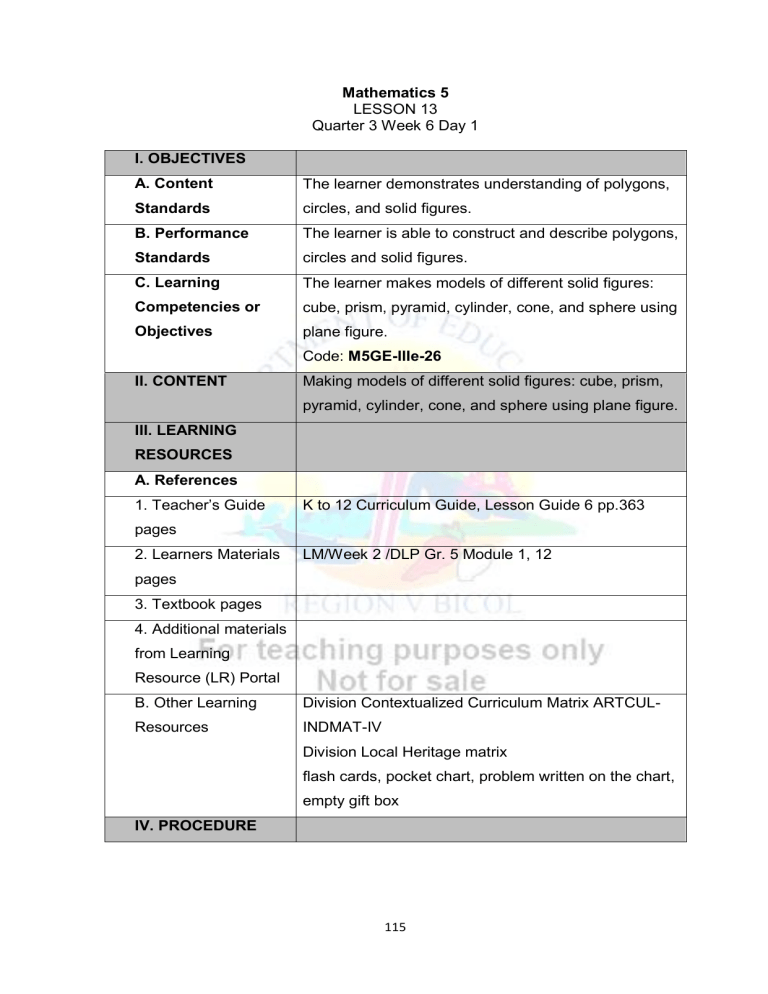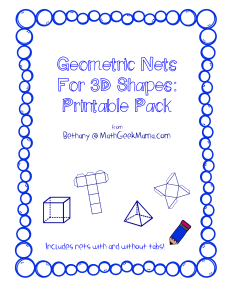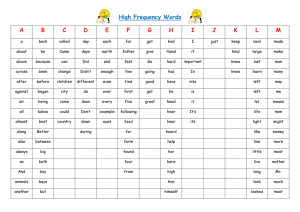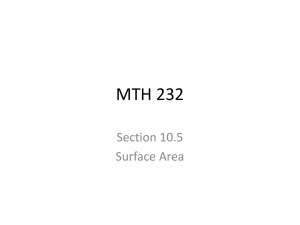
Mathematics 5 LESSON 13 Quarter 3 Week 6 Day 1 I. OBJECTIVES A. Content The learner demonstrates understanding of polygons, Standards circles, and solid figures. B. Performance The learner is able to construct and describe polygons, Standards circles and solid figures. C. Learning The learner makes models of different solid figures: Competencies or cube, prism, pyramid, cylinder, cone, and sphere using Objectives plane figure. Code: M5GE-IIIe-26 II. CONTENT Making models of different solid figures: cube, prism, pyramid, cylinder, cone, and sphere using plane figure. III. LEARNING RESOURCES A. References 1. Teacher’s Guide K to 12 Curriculum Guide, Lesson Guide 6 pp.363 pages 2. Learners Materials LM/Week 2 /DLP Gr. 5 Module 1, 12 pages 3. Textbook pages 4. Additional materials from Learning Resource (LR) Portal B. Other Learning Division Contextualized Curriculum Matrix ARTCUL- Resources INDMAT-IV Division Local Heritage matrix flash cards, pocket chart, problem written on the chart, empty gift box IV. PROCEDURE 115 A. Review previous 1. Drill lesson or presenting The teacher will flash pictures of real objects the new lesson that are models of space figures and the pupils will tell what kind of solid figures each pictures resembles. 2. Review Ask: What are the different kinds of solid figures? How does solid figure differ from plane figure? B. Establishing a purpose for the lesson Ask the pupils what special gifts did they received during special occasions like birthdays or Christmas day. Show different empty gift box. Ask the pupils what are those, what solid figures they are similar with and if they want to learn how to make them. Stress the importance of gift giving. C. Presenting Present the chart to the class. examples/instances of the new lesson Say: Using the nets we can make our own models of solid figures. D. Discussing new concepts and practicing new skills #1 The teacher will discuss the chart presented to the pupils, this time he/she will also use his/her own made nets of solid figures. He/she will have each pupils touch and describe the nets of solid figures presented by the him/her. 116 E. Discussing new concepts and practicing new skills #2 Group Activity Advance Average Task: Divide the class Task: Divide the class into 4 groups. Each into 4 groups. Each group will be assigned to group will be provided make their own model of nets of solid figures. solid figures using the Using the nets, they will nets that they will also make the model of solid make. figures assigned to each Group 1 – pyramid group. Group 2 – cube Group 1 – pyramid Group 3 – rectangular Group 2 – cube prism Group 3 – rectangular Group 4 - cylinder prism Group 4 - cylinder 2. Group Reporting Let them show the space figures they made that are different from the other group. Have them describe each and identify its parts. F. Developing mastery Ask: How did you find the activity? How did you make space figures? Were you able to create space figures correctly? Were you able to give the description of particular space figures? G. Finding practical applications of concepts and skills in daily living Have the pupils find the nets of the following figures: 117 H. Making generalizations and abstractions about the lesson I. Evaluating learning Ask: How do we make models of solid figures: cube, prism, pyramid, cylinder, cone, sphere using plane figures? Make each solid figure using art paper: 1. red pyramid 2. yellow rectangular prism 3. green cone 4. violet cylinder 5. orange cube J. Additional activities for Construct at least one solid figure using card board or application or remediation cheap board. V. REMARKS VI. REFLECTION A. No. of learners who earned 80% in the evaluation. B. No. of learners who require additional activities for remediation who scored below 80%. C. Did the remedial lessons work? No. of learners who have caught up with the lesson. D. No. of learners who continue to require remediation. E. Which of my teaching strategies worked well? Why did these work? F. What difficulties did I encounter which my principal or supervisor can help me solve? G. What innovation or localized materials did I use./discover which I wish to share with other teachers? 118 Mathematics 5 LESSON 13 Quarter 3 Week 6 Day 2 I. OBJECTIVES A. Content The learner demonstrates understanding of polygons, Standards circles, and solid figures. B. Performance The learner is able to construct and describe polygons, Standards circles and solid figures. C. Learning The learner makes models of different solid figures: Competencies or cube and rectangular prism using plane figure. Objectives Code: M5GE-IIIe-26b II. CONTENT Making models of different solid figures: cube, prism, pyramid, cylinder, cone, and sphere using plane figure. III. LEARNING RESOURCES A. References 1. Teacher’s Guide K to 12 Curriculum Guide, Lesson Guide 6 pp.363 pages 2. Learners Materials LM/Week 2 /DLP Gr. 5 Module 1, 12 pages 3. Textbook pages 4. Additional materials from Learning Resource (LR) Portal B. Other Learning Division Contextualized Curriculum Matrix ARTCUL- Resources INDMAT-IV Division Local Heritage matrix flash cards, pocket chart, problem written on the chart IV. PROCEDURE A. Review previous 3. Drill lesson or presenting The teacher will flash pictures of real objects the new lesson that are models of space figures and the pupils 119 will tell what kind of solid figures each pictures resembles. 4. Review Have the pupils describe the cube and rectangular prism. B. Establishing a purpose for the lesson Ask the pupils about the boxes of gifts they receive on Christmas or even on birthdays if they are all wrapped in the same size of boxes. C. Presenting Present the picture to the class. examples/instances of the new lesson Say: These are nets/patterns of cube and rectangular prism. Using these, we can make our own models of cube and rectangular prism. D. Discussing new concepts and practicing new skills #1 Ask: What is a geometry net? (A geometry net is a plane figure that can be folded to form a solid figure. Or a net is a pattern made when the surface of a solid figure is laid out flat showing each face of the figure. A solid figure may have different nets.) What is the plane figure of cube’s faces? Rectangular prism? How many? (A cube consists of six square faces, twelve edges, and eight vertices. The rectangular prism is made of two rectangular bases and four rectangular sides.) 120 E. Discussing new concepts and practicing new skills #2 Group Activity Advanced Average Task: Divide the class Task: Divide the class into 4 groups. Each into 4 groups. Each group will be assigned to group will be provided make their own model of nets of cube and cube and rectangular rectangular prism. Using prism using the nets that the nets, they will make they will also make. the model of cube and rectangular prism. 2. Group Reporting Let them show the cubes and rectangular prisms they made. Have them describe each and identify its parts. F. Developing mastery Ask: How did you find the activity? How did you make the cube and rectangular prism? Were you able to create them correctly? Were you able to give the description of particular solid figures? G. Finding practical applications of concepts and skills in daily living Choose which is the correct net for the given solid H. Making generalizations and abstractions about the lesson Ask: How do we make models of cube and rectangular figure. prism using plane figures? (We can make models of cube and rectangular prism using nets or patterns.) 121 I. Evaluating learning Make your own cube and rectangular prism using used folders or cardboard. J. Additional activities for Make your own gift box. Apply what you have learned application or remediation from making cube and rectangular prism. Be ready to present it to the class. V. REMARKS VI. REFLECTION A. No. of learners who earned 80% in the evaluation. B. No. of learners who require additional activities for remediation who scored below 80%. C. Did the remedial lessons work? No. of learners who have caught up with the lesson. D. No. of learners who continue to require remediation. E. Which of my teaching strategies worked well? Why did these work? F. What difficulties did I encounter which my principal or supervisor can help me solve? G. What innovation or localized materials did I use./discover which I wish to share with other teachers? 122 Mathematics 5 LESSON 14 Quarter 3 Week6 Day 3 I. OBJECTIVES A. Content Standards B. Performance Standards C. Learning II. The learner demonstrates understanding of polygons, circles, and solid figures. The learner is able to construct and describe polygons, circles and solid figures. The learner makes models of different solid figures: Competencies or cone and pyramid using plane figure. Objectives M5GE-IIIe-26c CONTENT Making models of different solid figures: cone and pyramid using plane figure. III. LEARNING RESOURCES A. References 1. Teacher’s Guide K to 12 Curriculum Guide, Lesson Guide 6 pp.363 pages 2. Learners Materials LM/Week 2 /DLP Gr. 5 Module 1, 12 pages 3. Textbook pages 4. Additional materials from Learning Resource (LR) Portal B. Other Learning Resources Division Contextualized Curriculum Matrix ARTCULINDMAT-IV Division Local Heritage matrix flash cards, pocket chart, problem written on the chart, picture of pyramid IV. PROCEDURE 123 A. Review previous Have the pupils present the gift boxes they lesson or made, applying the skills learned in making presenting the new cube and rectangular prism. lesson How do we make models of cube and rectangular prism? B. Establishing a purpose for the lesson Show pictures of pyramids of Giza. Let the pupils describe it. Ask: Have you ever wondered how the Egyptians made it? C. Presenting Present models of cone and pyramid. examples/instances of Have the pupils describe each of them. the new lesson Ask: How many edges, vertices and faces cone and pyramid has? How does the cone and pyramid differ from each other? D. Discussing new concepts and practicing new skills #1 Ask: What shapes makes up a cone and pyramid? (A cone has a curved face and a flat face. The flat face is a circle; the curved face is a curved triangle. A pyramid consists of one rectangle and four triangles.) Show the nets of cone and pyramid. Say: using these net we can make models of cone and pyramid. 124 E. Discussing new concepts and practicing new skills #2 Group Activity Advanced Average Task: Divide the class Task: Divide the class into 4 groups. Each into 4 groups. Each group will be assigned to group will be provided make their own model of nets of cone and cone and pyramid using pyramid. Using the nets, the nets that they will they will make the model also make. of cone and pyramid. 2. Group Reporting Let them show the cones and pyramids they made. Have them describe each and identify its parts. F. Developing mastery Ask: How did you find the activity? How did you make the cone and pyramid? Were you able to create them correctly? Were you able to give the description of particular solid figures? G. Finding practical applications of concepts and skills in daily living Ask: Is a cone a pyramid? (No. A pyramid is a special case of a cone and therefore you can refer a pyramid as a cone but not the other way around. It is easy to see the close relationship between pyramids and cones. The only difference is the base--a pyramid is a cone with a polygonal base.) H. Making generalizations and abstractions about the lesson Ask: How do we make models of cone and pyramid using plane figures? (We can make models of cone and pyramid using nets or patterns.) I. Evaluating learning Make your own cone and pyramid using used folders or cardboard. 125 J. Additional activities for Make your own Pyramids of Giza. Apply what you application or remediation have learned from making cone and pyramid. Be ready to present it to the class. V. REMARKS VI. REFLECTION A. No. of learners who earned 80% in the evaluation. B. No. of learners who require additional activities for remediation who scored below 80%. C. Did the remedial lessons work? No. of learners who have caught up with the lesson. D. No. of learners who continue to require remediation. E. Which of my teaching strategies worked well? Why did these work? F. What difficulties did I encounter which my principal or supervisor can help me solve? G. What innovation or localized materials did I use./discover which I wish to share with other teachers? 126 Mathematics 5 LESSON 14 Quarter 3 Week6 Day 4 I. OBJECTIVES A. Content The learner demonstrates understanding of polygons, Standards circles, and solid figures. B. Performance The learner is able to construct and describe polygons, Standards circles and solid figures. C. Learning The learner makes models of different solid figures: Competencies or cylinder and sphere using plane figure. Objectives M5GE-IIIe-26d II. CONTENT Making models of different solid figures: cylinder and sphere using plane figure. III. LEARNING RESOURCES A. References 1. Teacher’s Guide K to 12 Curriculum Guide, Lesson Guide 6 pp.363 pages 2. Learners Materials LM/Week 2 /DLP Gr. 5 Module 1, 12 pages 3. Textbook pages 4. Additional materials from Learning Resource (LR) Portal B. Other Learning Division Contextualized Curriculum Matrix ARTCUL- Resources INDMAT-IV Division Local Heritage matrix flash cards, pocket chart, problem written on the chart IV. PROCEDURE A. Review previous Have the pupils present their own Pyramids of Giza lesson or presenting they made, applying the skills learned in making cone the new lesson and pyramid. How do we make models of cone and pyramid? 127 B. Establishing a purpose Ask: What is your favorite sports? Why? for the lesson Show different kinds of ball to the class and let the pupils identify each of them. (balls for basketball, volleyball, soccer and baseball.) Tell them the importance of engaging to sports. C. Presenting Present models of cylinder and sphere. examples/instances of Have the pupils describe each model. the new lesson Ask: Do you want to know how to make a model of cylinder and sphere? D. Discussing new concepts and practicing new skills #1 Show the nets of cylinder and sphere. Say: These are the nets of cylinder and sphere. It is impossible to make a perfect sphere (ball or globe) from a flat sheet of paper. Paper can curve in one direction, but cannot curve in two directions at the same time. Another way to make a sphere is with pointed ellipses. Globes can be made this way, since the edges of the net run along longitudes. The net of a cylinder consists of three parts: One circle gives the base and another circle gives the top. A rectangle gives the curved surface. 128 E. Discussing new concepts and practicing new skills #2 Group Activity Advanced Average Task: Divide the class Task: Divide the class into 4 groups. Each into 4 groups. Each group will be assigned to group will be provided make their own model of nets of cylinder and cylinder and sphere sphere. Using the nets, using the nets that they they will make the model will also make. of cylinder and sphere. 2. Group Reporting Let them show the cylinder and sphere they made. Have them describe each and identify its parts. F. Developing mastery Ask: How did you find the activity? How did you make the cone and pyramid? Were you able to create them correctly? Were you able to give the description of particular solid figures? G. Finding practical applications of concepts and skills in daily living Ask: What is the difference between cylinder, cone and sphere? (A cylinder is similar to a prism, but its two bases are circles, not polygons. Also, the sides of a cylinder are curved, not flat. A cone has one circular base and a vertex that is not on the base. The sphere is a space figure having all its points an equal distance from the center point.) H. Making generalizations and abstractions about the lesson Ask: How do we make models of cylinder and sphere using plane figures? (We can make models of cylinder and sphere using nets or patterns.) J. Evaluating learning Make your own cylinder and sphere using used folders or cardboard. 129 J. Additional activities for Make your own models of balls for basketball, application or remediation volleyball, and soccer. Apply what you have learned from making cylinder and sphere. Be ready to present it to the class. V. REMARKS VI. REFLECTION A. No. of learners who earned 80% in the evaluation. B. No. of learners who require additional activities for remediation who scored below 80%. C. Did the remedial lessons work? No. of learners who have caught up with the lesson. D. No. of learners who continue to require remediation. E. Which of my teaching strategies worked well? Why did these work? F. What difficulties did I encounter which my principal or supervisor can help me solve? G. What innovation or localized materials did I use./discover which I wish to share with other teachers? 130 Mathematics 5 LESSON 15 Quarter 3 Week6 Day 5 I. OBJECTIVES A. Content Standard B. Performance Standard C. Learning Competencies / Objectives II. CONTENT III. LEARNING RESOURCES A. References 1. Teacher’s Guide pages 2. Learner’s Materials pages 3. Textbook pages The learner demonstrates understanding of the concept of sequence and solving simple equations. The learner is able to apply the knowledge of sequence in various situations. The learner formulates the rule in finding the next term in a sequence. M5AL-IIIf-6 Formulating the rule in finding the next term in a sequence involving one operation 21st Century Mathletes, p.233 & p. 235 Exploring Math Possibilities 5, pp. 250-251, pp.255-256 Charts or tarpapel or Powerpoint presentation(with laptop, projector/TV screen) picture Manila paper and marker for group work 4. Additional Materials from Learning Resource (LR) Portal B.Other Learning Resources IV. PROCEDURES A. Reviewing previous lesson or presenting the new lesson Identify the following solid figures. B. Establishing a purpose for the lesson Look at the picture on page 250 of the LM. Tell what is on the picture. 131 Have you receive a gift from a special someone or from your love ones? What gifts did you receive from them?Describe the feeling when a person was given a gift from love ones. C. Presenting Examples/Instances of new lesson Engage,page 250 of LM Seven days before his mother’s birthday, Clark planned to give her gifts. On the first day , he sent one gift. On the second day, he sent three gifts.On the third day, he sent five gifts, and so on. How many gifts did Clark send his mother on the seventh day? Explore, pages 250-251 of LM D. Discussing new concepts and practicing new The table shows the number of gifts given by Clark skills #1 rd Day No of Gift s E. Discussing new concepts and practicing new skills #2 1st 1 2nd 3 3 5 4th 5th 6th 7th ? ? ? ? Upon observing the number of gifts, the pattern shown is +2. Explain how to get the term on the 7th day. There are problems in Math that can be solved by observing sequences and patterns. Differentiate a Sequence from a pattern. (A sequence is a list of numbers or objects in a defined or logical order.)p. 251 (Patterns are repetitive sequences and can be found in nature, shapes, events, set of numbers and almost everywhere.) p. 251 See example 1, p. 251 Find the next three terms of the sequence 2,5,8,_____,_____,_____,… Answer is 11,14,17 We find the answers by adding 3. Rule: +3 See example 2, p. 251 Find the next three terms of the sequence 3,6,9,12,24,____,_____,_____ The answer is 48,96,192 We find the answers by multiplying by 2. Rule: x2 132 Present other example and determine the rules applied: 100,98,96,94,92,90,88 (rule is -2) 4,20,100,500,2500,… (rule is x5) 2000,1000,500,250,125 (rule is ÷2) 25,28,31,34,37,40,43,46,… (rule is +3) There are many rules that may apply using one operation +, - , x , or ÷ Rules are determined through observing the patterns. Developing mastery (Leads to Formative Assessment) AVERAGE LEARNERS Find the next three terms in a sequence and state the rule GROUP 1: 1.) 2,4,6,8,_____,______,_____ Rule__________ 2.) 3,6,8,10,_____,_____,_____ Rule__________ 3.) 5,10,15,20,_____,______,____ Rule__________ GROUP 2: 1) 2,4,8,16,_____,_____,_____ Rule__________ 2) 3,9,27,_____,______,_____ Rule__________ 3) 1,5,25,______,______,_____ Rule__________ GROUP 3: 1) 21, 25,29,33,_____,______,_____,… Rule__________ 2) 11,44,176, _____,_____,_____,… Rule__________ 3) 105,100,95,90,_____,_____,___ Rule__________ ADVANCE LEARNERS Find the missing terms to complete the sequence. Write the rule being used. GROUP 1: 1) 3,18, 24,30,_____,_____,48,… Rule__________ 2) 4,_____,_____,32,64,128,… Rule__________ 3) 1,4,16,______, 256,1024,… Rule__________ GROUP 2: 1) ______, 500,440,380,______ Rule__________ 2) 90, 140,190,_____,______,340 Rule__________ 3) ____, 36,108,324,_____,2916 Rule__________ 133 G. Finding practical applications of concepts and skills in daily living H. Making generalizations and abstractions about the lesson I. Evaluating Learning J. Additional activities for application and remediation V.REMARKS VI.REFLECTION A. No. of learners who earned 80% in the evaluation B. No. of learners who require additional activities for remediation C. Did the remedial work? No. of learners who have caught up with the lesson D. No. of learners who continue to require remediation E. Which of my teaching strategies worked well? Why did these work? F. What difficulties did I encounter which my principal or supervisor can help me solve? G. What innovation or localized materials did you use/discover which I wish to share with other teachers? GROUP 3: 1) 27054,_______,3006,1002,______ 2) 109,134,_____,______,_____,_____,259 3) 910,960,______,_____,1110,1160 Rule__________ Solve: 1. Nicole is writing a poem. She writes 6 words on the first liNe, 12 words on the second line, 24 words on third line and 48 words on the fourth line. If this continues, how many words will Nicole on the fifth line? How do you formulate rule in finding the next term in a sequence? A sequence is a list of numbers or objects in a defined or logical order.Rules are determined through observing the next terms. State the rule in the following sequence. 1. 2,3,4,5 2. 2,4,8,16 3. 7,14,21,28 4. 6,11,16,21 5. 10,16,22,28 Solve Evaluate, letter A,1-8 only on page 255 of the LM 134



![Volume of Pyramids, Cones, and Spheres [12/4/2013]](http://s2.studylib.net/store/data/005724855_1-4c0eaf218975fc4d9fe792c18193e4dc-300x300.png)